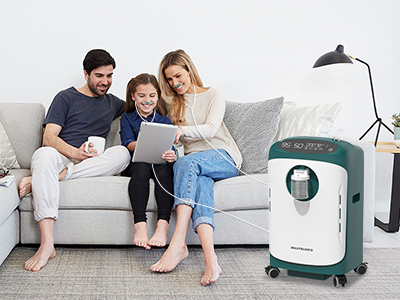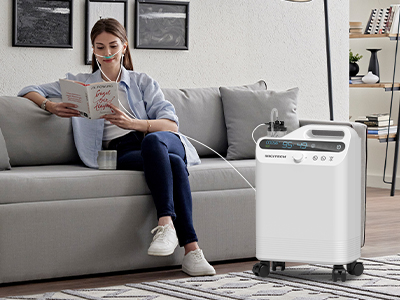17 Feb 2025
Oxygen is one of the most essential elements for sustaining life. In the medical field, oxygen therapy has become a cornerstone of treatment for various conditions, offering patients a vital source of life-sustaining air when they are unable to obtain sufficient oxygen from their environment. Its uses extend beyond respiratory disorders and encompass a range of medical conditions and therapeutic needs.
Whether in hospitals, homes, or during emergencies, oxygen therapy has proven to be a flexible, adaptable solution to a host of medical challenges. This article explores the diverse application scenarios where oxygen plays a pivotal role in improving patient outcomes and enhancing recovery.

Oxygen Therapy in Chronic Respiratory Diseases
Chronic respiratory diseases, such as Chronic Obstructive Pulmonary Disease (COPD) and emphysema, often lead to impaired lung function, resulting in decreased oxygen absorption. For patients struggling to breathe effectively, oxygen therapy is critical in maintaining adequate blood oxygen levels, thereby reducing the strain on the heart and other organs.
Asthma, though less chronic than COPD, can also benefit from supplemental oxygen during severe attacks. During an asthma exacerbation, oxygen therapy helps prevent hypoxemia (low oxygen levels in the blood), ensuring that vital organs function properly.
In all of these conditions, oxygen therapy helps improve exercise tolerance, reduce breathlessness, and significantly enhance the quality of life. It is often prescribed as part of a long-term treatment plan to prevent exacerbations, decrease hospital admissions, and prolong life expectancy.
Emergency Use of Oxygen
In emergency settings, oxygen therapy is an essential first-line treatment. Oxygen is often administered in trauma cases to stabilize the patient, prevent brain damage, and support critical organ functions. For instance, in cases of traumatic injury or blood loss, supplemental oxygen helps counteract the effects of hypoxia, which can be fatal if left untreated.
Similarly, in conditions like shock, pneumonia, or acute heart failure, oxygen helps to stabilize the patient by improving oxygen delivery to tissues, thus preventing organ dysfunction. During severe asthma attacks or exacerbations of COPD, oxygen supplementation is a key intervention to alleviate breathing difficulties, ensure airway patency, and prevent respiratory failure.
oxygen levels. It is typically administered via a mask, nasal cannula, or through more advanced methods, such as non-invasive positive pressure ventilation (NIPPV) or intubation in critical cases.
Oxygen for Post-Surgical Recovery
After surgery, oxygen therapy can be crucial for patient recovery, especially in individuals undergoing major surgeries like cardiac surgery, organ transplants, or respiratory operations. Surgery often places stress on the body’s oxygen needs, particularly in the early postoperative period when the body is adjusting and healing.
Oxygen therapy helps by ensuring tissues and organs receive adequate oxygen during this time, reducing complications such as hypoxemia, infection, and organ failure. It accelerates wound healing, reduces the risk of complications, and contributes to a faster and more comfortable recovery process.
Tailoring oxygen therapy after surgery involves determining the optimal flow rate based on the patient’s clinical status and oxygen requirements. Monitoring of oxygen saturation levels helps healthcare professionals adjust therapy as the patient recovers and their condition stabilizes.
Oxygen in Sleep Disorders
Sleep apnea is a common disorder where a patient’s breathing repeatedly stops and starts during sleep, leading to drops in oxygen levels and frequent awakenings throughout the night. For individuals suffering from sleep apnea, supplemental oxygen is a beneficial treatment that improves oxygen saturation levels and enhances sleep quality.
Continuous Positive Airway Pressure (CPAP) machines, commonly used to treat obstructive sleep apnea (OSA), can be equipped with oxygen supplementation to maintain stable blood oxygen levels during sleep. By providing a constant flow of air mixed with oxygen, CPAP with oxygen therapy can prevent oxygen desaturation, improving both the duration and quality of sleep.
In cases of central sleep apnea or complex sleep apnea, where the issue lies in the brain’s inability to regulate breathing, oxygen therapy may be used in conjunction with devices like BiPAP or adaptive servo-ventilation (ASV) to optimize breathing and oxygen delivery.

Oxygen in Sports and Athletic Performance
Athletes, particularly those in high-endurance sports, often turn to supplemental oxygen to enhance performance and speed up recovery. During intense exercise, oxygen demand in the body increases. Oxygen supplementation can help athletes maintain a higher level of performance, delay fatigue, and speed up recovery times by replenishing oxygen levels in the muscles.
During training, some athletes use portable oxygen concentrators to accelerate their recovery from strenuous workouts, reducing muscle soreness and improving overall endurance. Additionally, post-training oxygen therapy promotes faster healing of muscle tissue, reduces inflammation, and enhances aerobic capacity.
Though the use of supplemental oxygen in sports is not universally endorsed, there is considerable evidence supporting its positive impact on recovery and performance. As research continues, the benefits of oxygen therapy in enhancing athletic performance may become more widely recognized.
Oxygen Therapy in High Altitude Environments
At high altitudes, the air pressure decreases, and the concentration of oxygen in the air diminishes. For climbers, hikers, and travelers, this can lead to hypoxia, where the body does not receive sufficient oxygen. Oxygen therapy is essential in these environments, providing an additional source of oxygen to prevent altitude sickness and hypoxic conditions.
Portable oxygen concentrators have become vital tools for those venturing into high-altitude environments, ensuring they can maintain adequate oxygen levels. Whether used during mountain expeditions, long-distance hiking, or traveling to cities located at high elevations, oxygen therapy helps reduce the risk of dizziness, nausea, and other symptoms associated with altitude sickness.
The ability to carry lightweight, portable oxygen concentrators has made it more feasible for travelers to explore higher altitudes without compromising their health. This application of oxygen therapy plays a crucial role in preventing hypoxic events, ensuring safety during high-altitude activities.
Oxygen in Neonatal Care
Neonatal respiratory distress syndrome (RDS) is a common condition in premature infants, whose lungs are often underdeveloped. Oxygen therapy is vital in these infants, ensuring they receive enough oxygen for proper development while preventing complications like brain damage or organ failure.
Oxygen therapy in neonates requires careful monitoring and precise regulation of oxygen levels. In neonatal intensive care units (NICUs), oxygen is administered through nasal cannulas, oxygen tents, or mechanical ventilation, depending on the severity of the condition. Careful management is critical to avoid oxygen toxicity or excessive oxygen exposure, which can cause damage to delicate lung tissue.
Neonatal oxygen therapy is a delicate balance, requiring constant monitoring to ensure the infant’s oxygenation remains within a safe range.
Home Oxygen Therapy for Chronic Conditions
For individuals with chronic illnesses such as COPD, pulmonary fibrosis, or severe asthma, long-term home oxygen therapy can significantly improve quality of life. By using oxygen concentrators or portable oxygen cylinders, patients can maintain stable oxygen levels in the comfort of their homes. This reduces hospital admissions, enhances daily functionality, and allows patients to remain independent for longer.
Healthcare professionals must closely monitor these patients, adjusting oxygen flow rates and therapy as their condition evolves. Patient education is key, ensuring individuals understand the importance of adherence to prescribed oxygen levels and how to use their devices safely.
Innovative Uses of Oxygen in Alternative Therapies
In addition to its widespread applications in treating respiratory disorders, oxygen is also being explored for its therapeutic potential in treating non-respiratory conditions. Hyperbaric oxygen therapy (HBOT) has gained recognition for its ability to speed up healing in wounds, burns, and chronic injuries by delivering pure oxygen at higher-than-normal atmospheric pressures.
HBOT has also shown promise in treating conditions such as stroke recovery, carbon monoxide poisoning, and even some forms of cancer. As research expands, alternative applications for oxygen continue to evolve, further emphasizing its versatility in medical care.
Conclusion
From chronic respiratory diseases to post-surgical recovery, emergency care, sports recovery, and even neonatal care, oxygen plays a vital role in sustaining life and improving health outcomes.
As technology continues to advance, the possibilities for oxygen therapy expand, ensuring better quality of life for patients and enhancing healthcare professionals' ability to provide optimal care. Oxygen’s adaptability and significance in modern medicine cannot be overstated, making it a critical element in a wide range of therapeutic applications.
Keywords: oxygen
Originally published 17 Feb 2025, updated 17 Feb 2025.